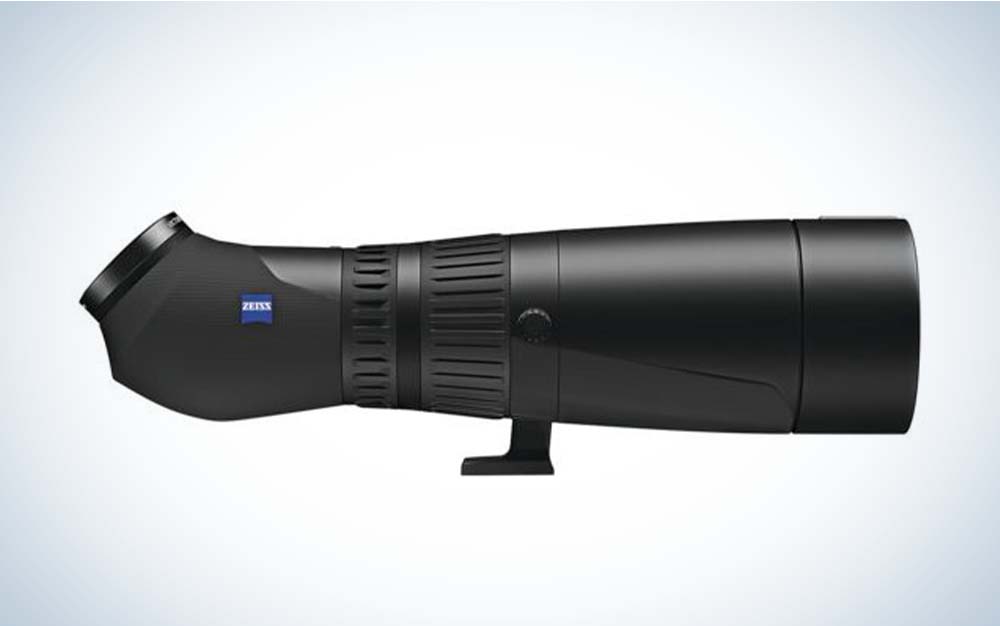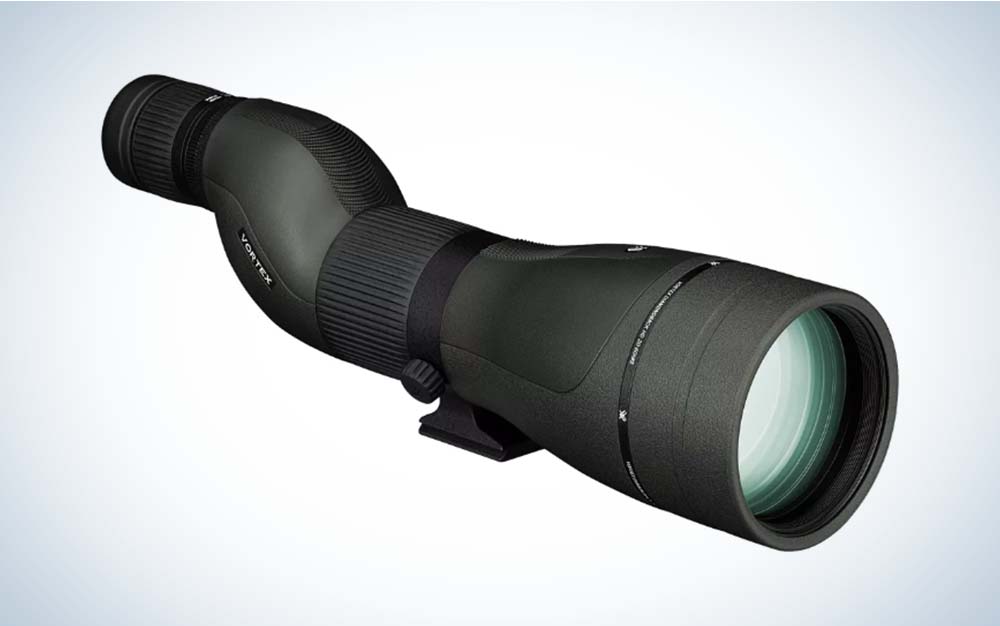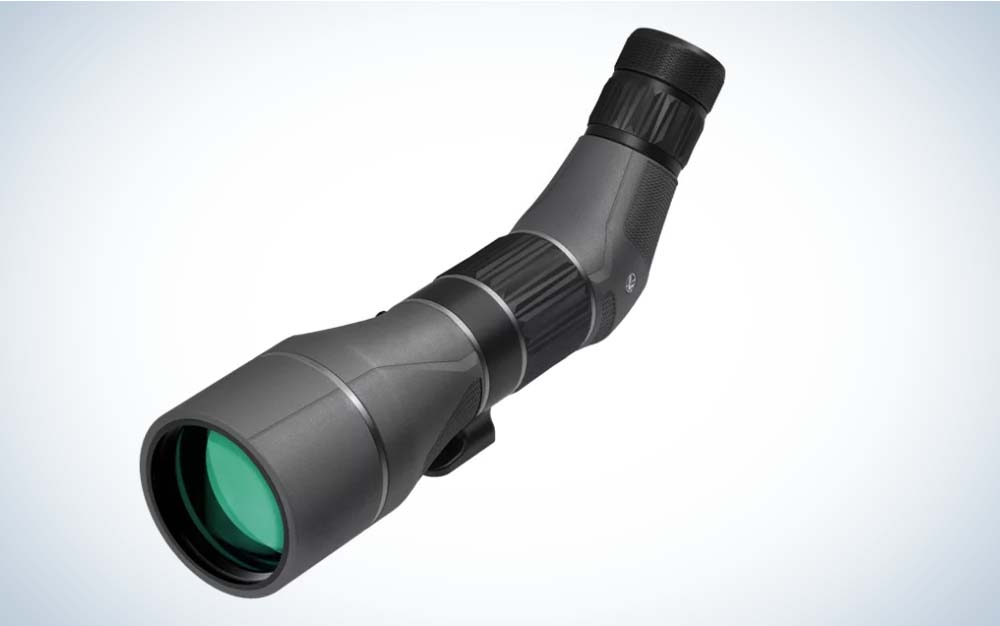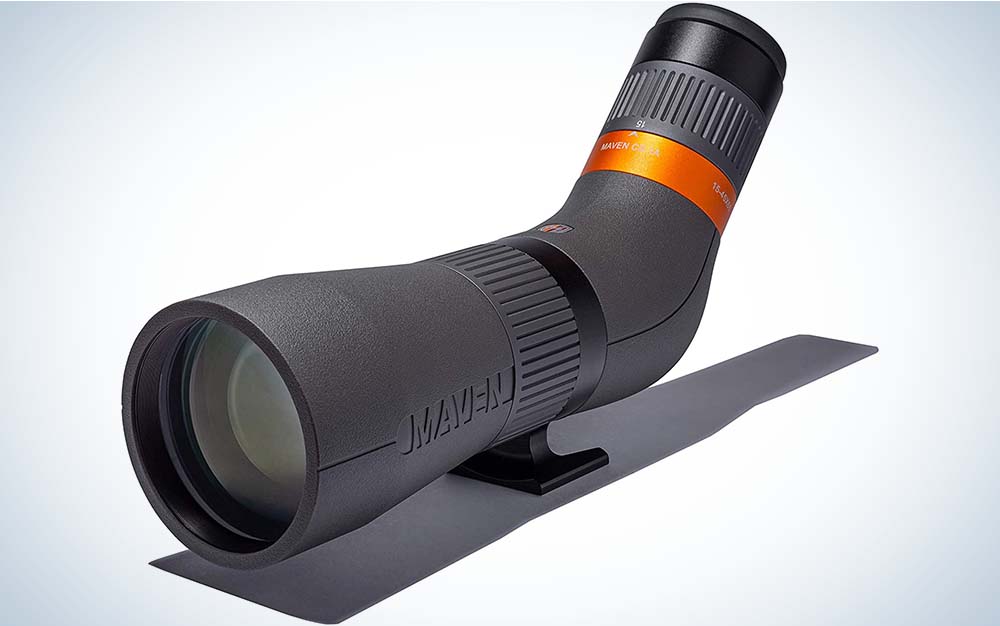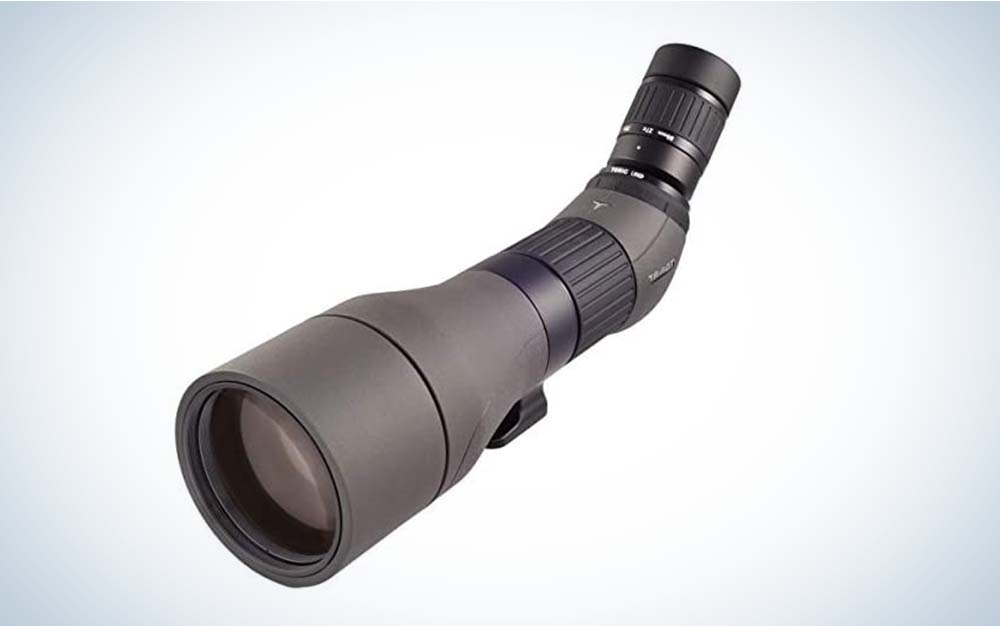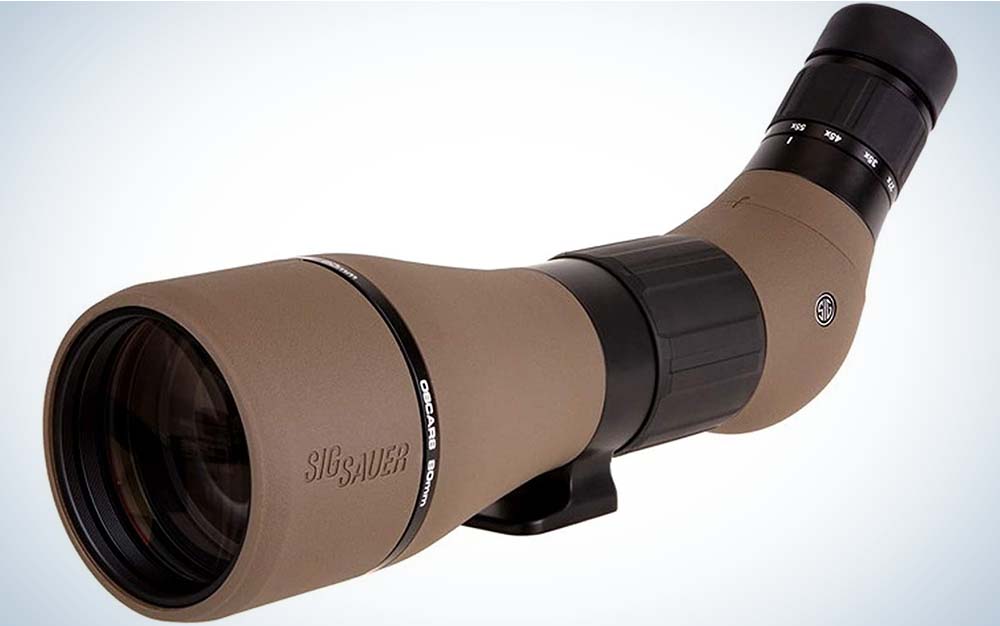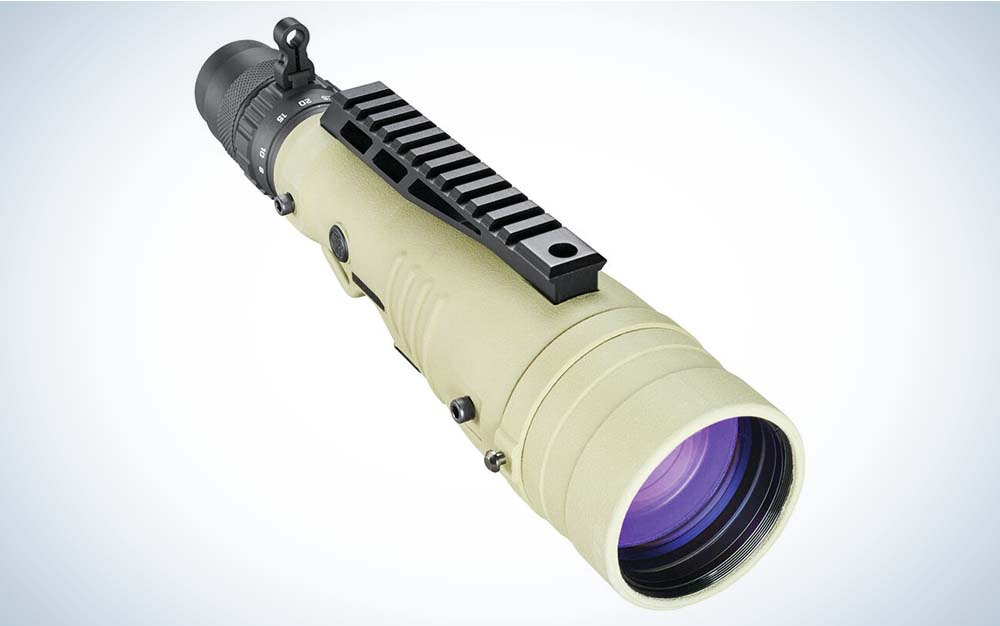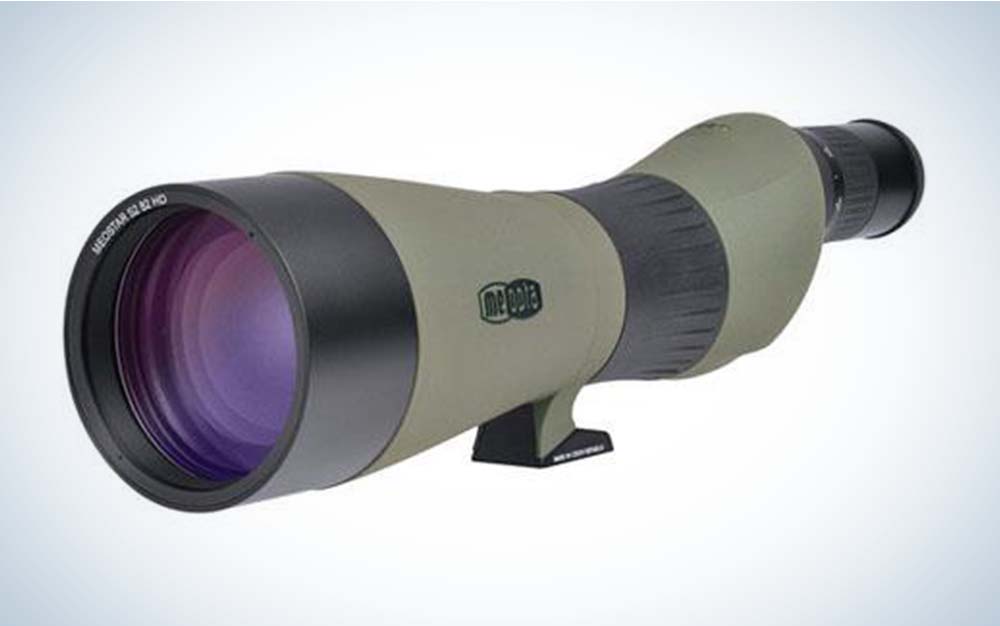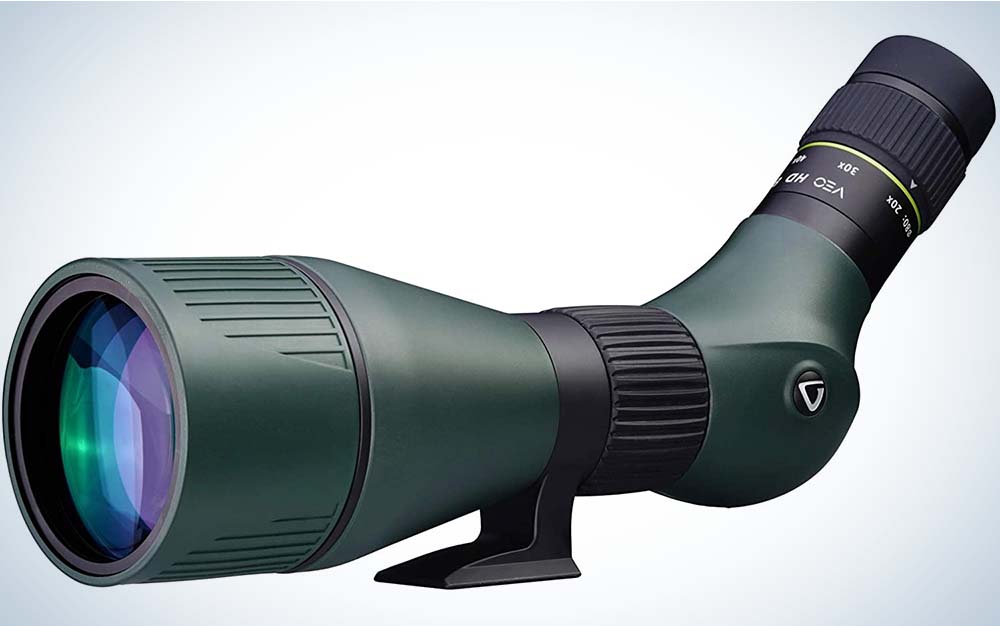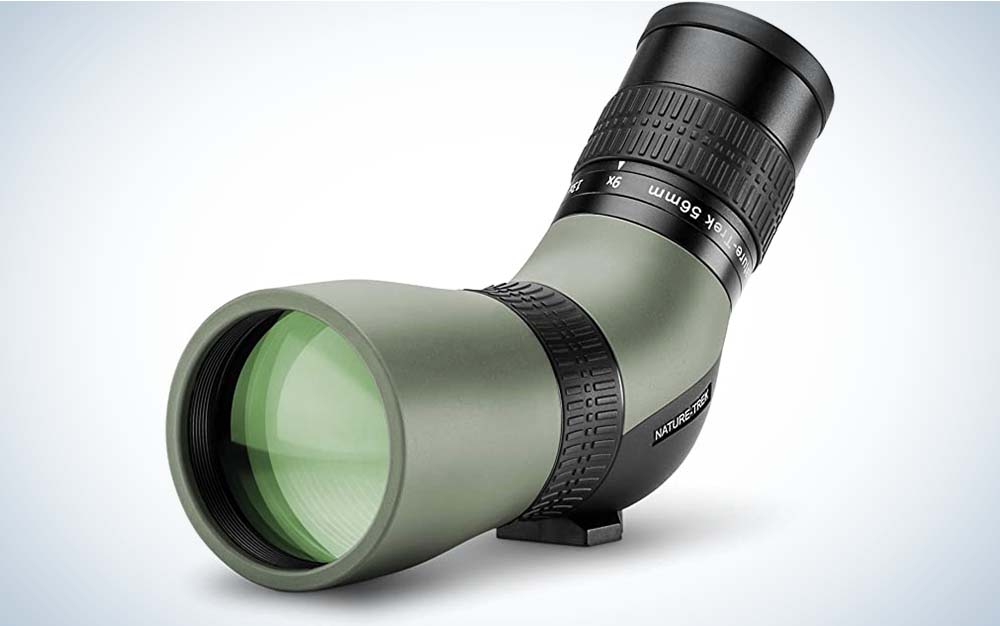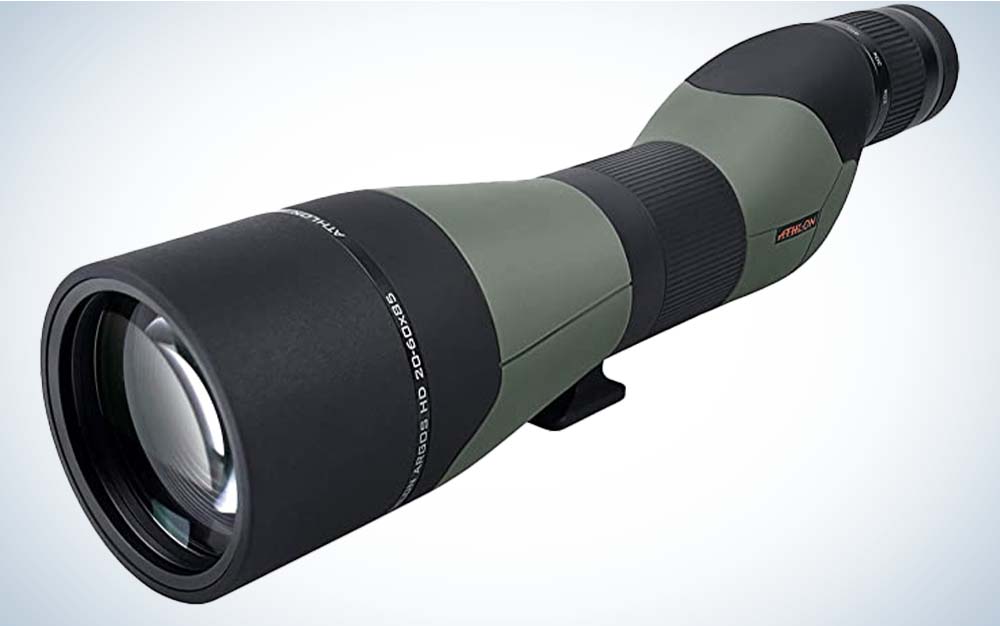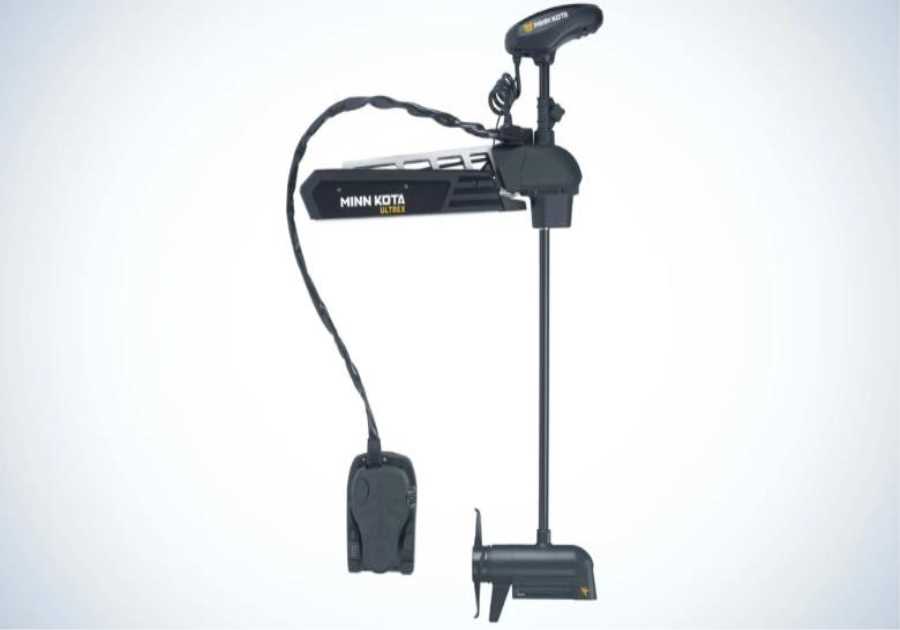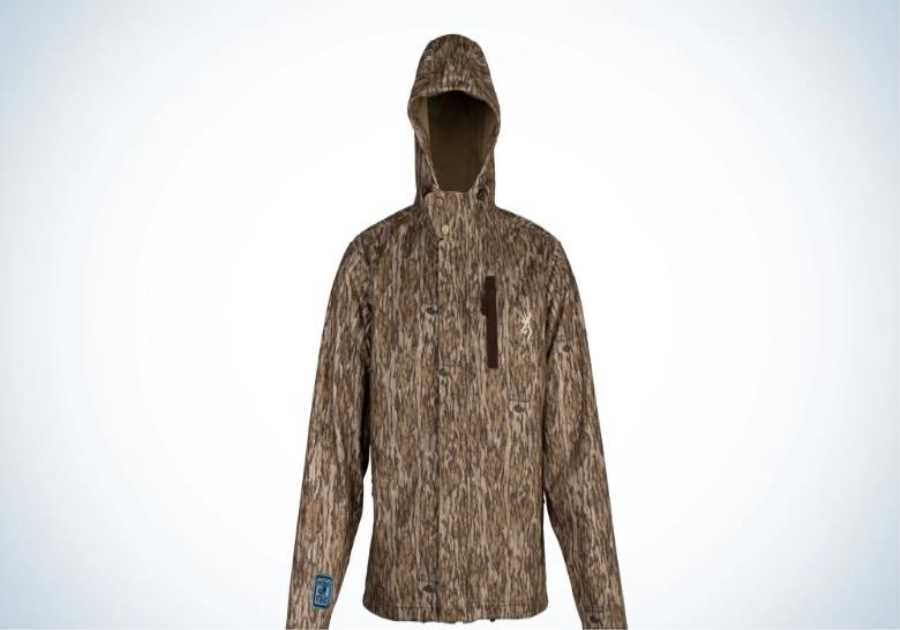||
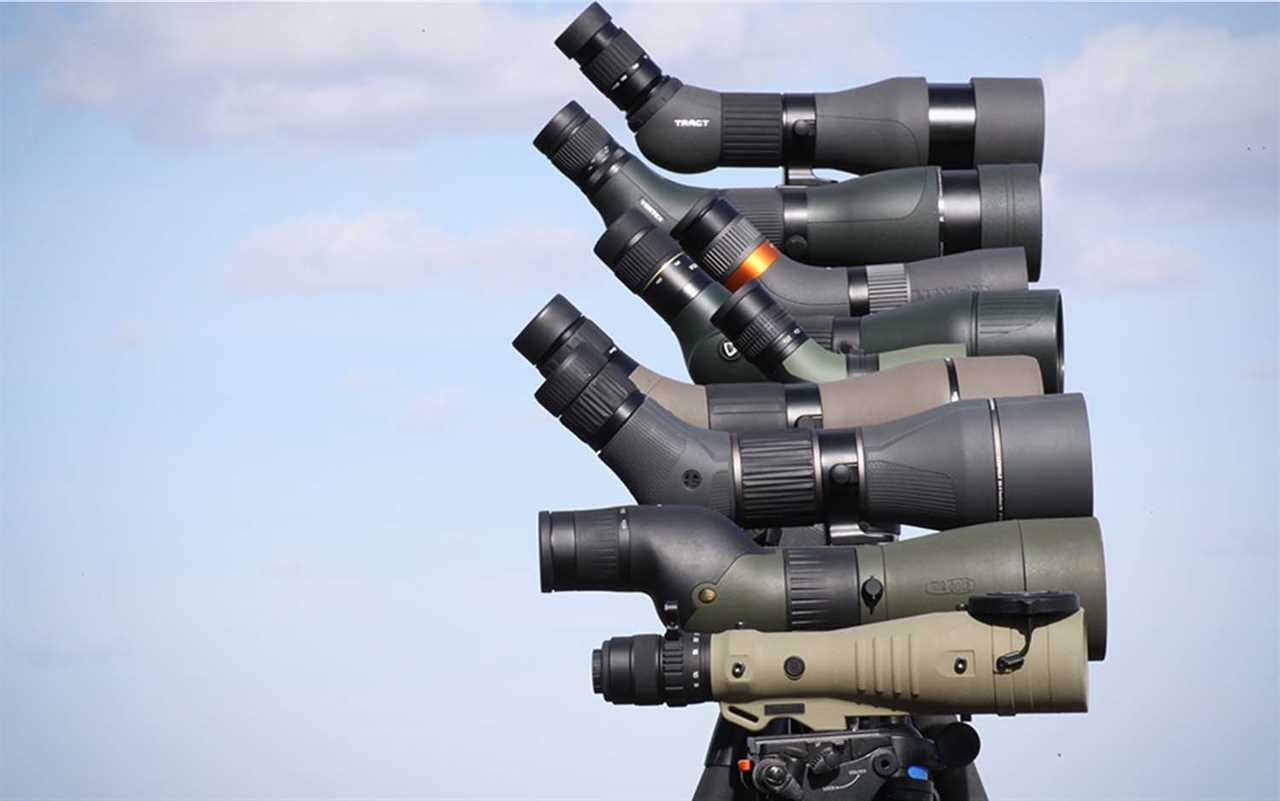
| Best Budget |
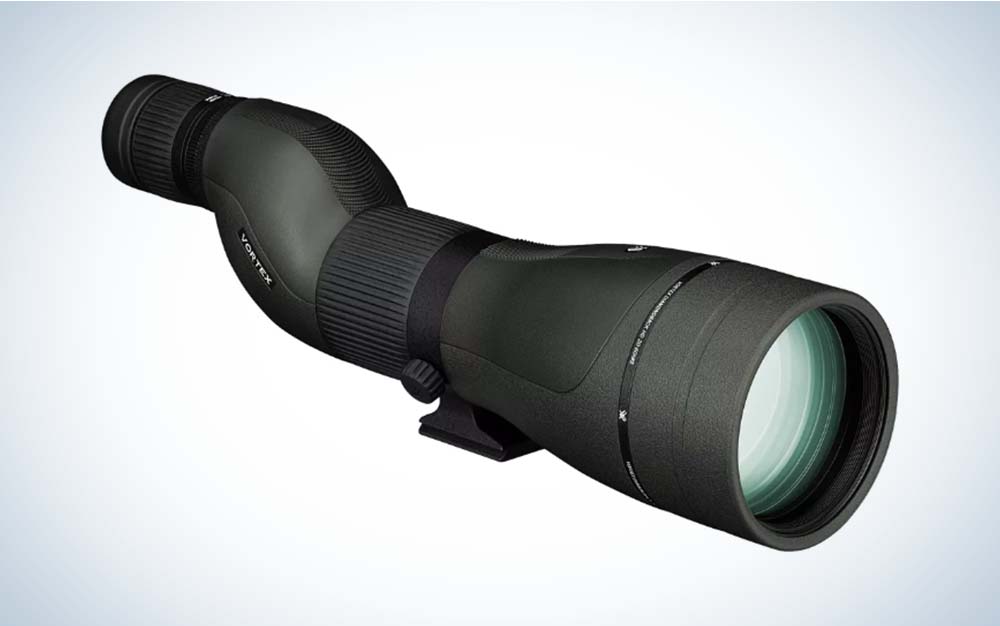
|
Vortex Diamondback HD 20-60×85 | Check Price |
LEARN MORE
|
Summary
A durable and versatile scope for a fraction of premium scopes’ price points. |
| Best Value |
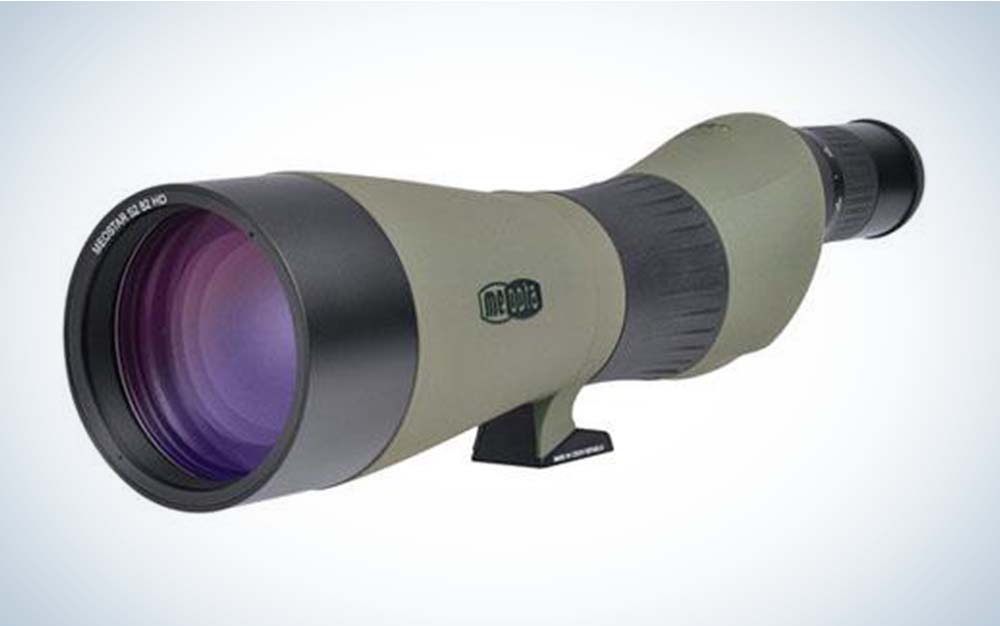
|
Meopta MeoStar S2 82HD | Check Price |
LEARN MORE
|
Summary
Fast target acquisition, excellent glass, and interchangeable eye pieces. |
| Best Compact |

|
Maven CS.1A 15-45×65 | Check Price |
LEARN MORE
|
Summary
Packs easily and brings excellent optics and durability to the field. |
Spotting scopes aren’t for everyone or for every outdoor pursuit. They’re heavy, often require tripods for stability, and are even unwieldy. And the most expensive ones can cost you several thousand dollars. However, they’re also indispensable for many purposes like assessing distant animals during a hunt, determining whether you hit or missed a steel target at a mile, and whether that bird you’re glassing is a rare specimen or a common species.
- Best Premium: Zeiss Victory Harpia 95 23-70×95
- Best Budget: Vortex Diamondback HD 20-60×85
- Best Durable: Leupold SX-5 Santiam HD 27-55×80
- Best Compact: Maven CS.1A 15-45×65
- Best Crossover: Tract Toric UHD 27-55×80
- Best Versatile: SIG Sauer OSCAR8 20-55×80
- Best Tactical: Bushnell Elite Tactical LMSS2 8-40×60
- Best Value: Meopta MeoStar S2 82HD
- Best Entry-level: Vanguard VEO HD 80A 20-60×80
- Best Micro: Hawke Nature-Trek 9-27×56
While spotters share many key attributes in common—including a single tube and variable-power eyepieces—they can also differ in many ways. And picking the right one for your own needs requires handling lots of candidates. To eliminate this time and guesswork, I tested the best spotting scopes for a variety of applications, so you can determine which one best fits your specific needs.
Things to Consider Before Buying a Spotting Scope
Price
Given that you can spend anywhere from a couple hundred to several thousand dollars on a new spotting scope, it’s important to know what you get—and don’t get—at each price point. And since everyone works with a different budget, you’ll want to consider which of the best spotting scopes fits your needs and price range.
Size
The largest units, those with 80 to 85mm objective lenses, often weigh between 3 and 4 pounds and can come with their own carrying cases. They do not come with tripods, like the Spartan Precision Ascent, an essential accessory to stabilize the big optics, so you can get a vibration-free viewing platform.
Purpose
Do you want a spotter that you can stuff in your pack for the last miles of a backcountry hunt? Or do you want a spotter to view distant birds or horizons from your patio deck? You might even want a tiny spotter that you can slip into a pocket in place of compact binoculars or a monocular.
Value
Some spotting scopes include a carrying case, a dust-resistant neoprene cover, a tripod plate, and usually some type of warranty. However, some do not include these things. And if you’re trying to get the best bang for your buck, you might want to consider if it’s worth dropping a load of cash for an option that requires you to buy these necessary features. Spotting scopes are big, fragile, expensive optics, and the best have excellent lifetime warranties to protect your investment in case something goes sideways. A spotting scope that costs more but has a lifetime warranty may end up saving you money in the long run.
Best Premium: Zeiss Victory Harpia 95 23-70×95
Key Features
- Magnification: 23-70x
- Objective lens: 95mm
- Weight: 73.3 ounces
- LotuTec lens coating
- Dual-speed focus
Why It Made the Cut
This pricey, indulgent, magnum-sized optic is the last spotting scope you’ll own, and it parses details like no other spotter in this category.
Pros
- World-class fluorite glass
- Fast, precise focusing
- Surprisingly wide field of view
- Light-gobbling 95mm objective
Cons
- Stratospheric price
- No magnification indexing on eyepiece
Product Description
Once you look through Zeiss’s Harpia spotter, no other scope will quite satisfy you. The image delivered by the 23-70-power eyepiece is stunning, and the amount of light delivered to the eye through the 95mm objective lens makes even low-light glassing a pleasure. The two-speed focus control allows you to riff from close-in to far-distant targets with a single revolution, and then feather the focus for precision. However, at 4.5 pounds, this is a beast to pack, which makes it a better choice for a back deck or base camp optic. And at nearly $4,000, most of us aren’t willing to subject the Harpia to the indignities and dings of the field. That’s too bad, because it’s durable and well-balanced for just about any tripod work.
The Harpia 95 has a little sister, the Harpia 85, that’s a little more portable and only slightly more affordable. But for hunters who aspire to own the best optics on the planet, this line of Zeiss spotters justifies the significant investment.
Best Budget: Vortex Diamondback HD 20-60×85
Key Features
- Magnification: 20-60x
- Objective lens: 85mm
- Weight: 60.9 ounces
- Angled eyepiece
- Ships with neoprene cover
- Compatible with Arca-Swiss mounts
Why It Made the Cut
Full-sized spotting scopes can cost well over $2,000. At a fraction of that price, this Vortex delivers an adequate image in a durable, versatile package.
Pros
- Entry-level price point
- Ships with close-fitting neoprene cover
- Retractable sunshade
- Fully-transferable lifetime warranty
Cons
- Image gets dark at high magnifications
- Underwhelming optics
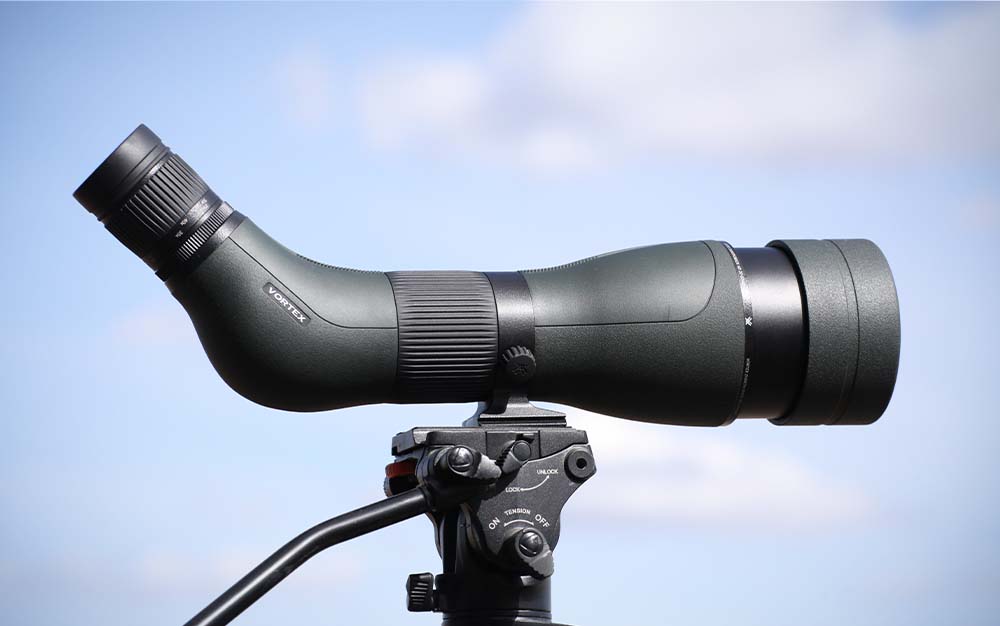
Product Description
This spotter makes an excellent choice for a hunter who wants a versatile spotting scope without paying a month’s wages. The Diamondback HD has decent high-definition glass in the objective lens, but experienced hunters may be disappointed with the clarity and brightness of the image. Its angled body, with rotating tripod ring, allows for infinite adjustment, and the Arca-Swiss compatible tripod system mates up with any number of mounting options.
The Diamondback HD spotter makes an accessible, extremely usable optic for any number of well-lighted conditions. Its optical shortcomings are evident in low light conditions, but that’s to be expected at this bargain price. However, with Vortex’s best-in-class warranty, you’ll never have to worry if it fails to perform.
Most Durable: Leupold SX-5 Santiam HD 27-55×80
Key Features
- Magnification: 27-55x
- Objective lens: 80mm
- Weight: 68.7 ounces
- Angled eyepiece
- Center-barrel focus
- Highly textured graphite armor
Why It Made the Cut
Big, grippy, and durable, the Santiam is a no-nonsense full-sized spotter that feels a little heavy for a walk-about optic but will give years of service as a base-camp, shooting-range, or pickup scope.
Pros
- Extremely tactile controls
- Lifetime transferable warranty
- Rugged protective armor
Cons
- Eyepiece isn’t removable
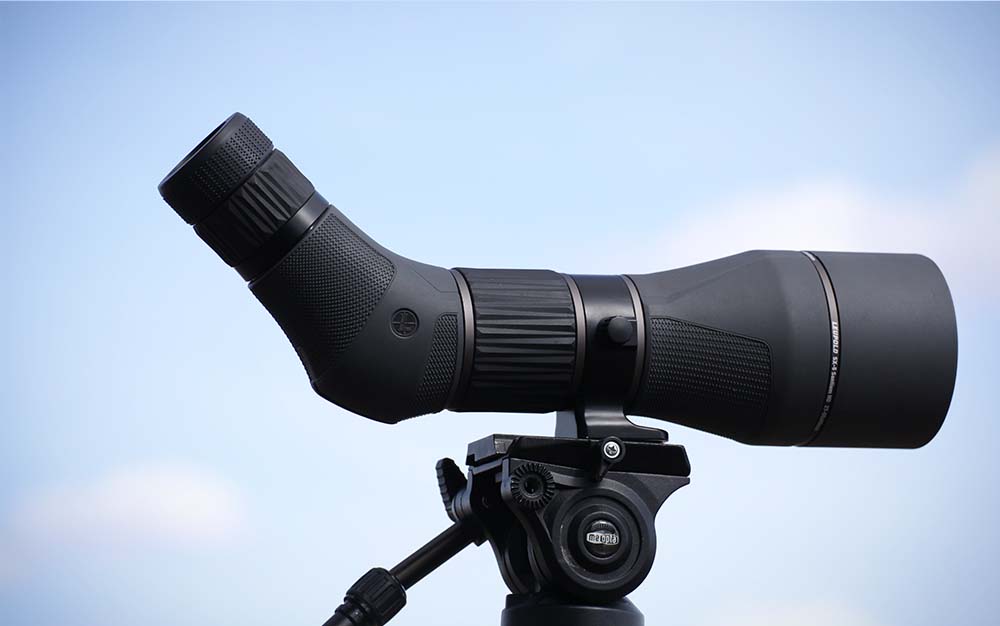
Product Description
Leupold’s flagship spotting scope delivers a quality image at pretty much every magnification. The 27 to 55x is the sweet spot for combining magnification with a reasonably bright image. At almost 4.3 pounds this spotter feels like a tank, which means it’s a better base-camp scope than a walk-about optic.
This durable one-piece design keeps dust out of the innards but also prevents users from trading out the variable-power eyepiece for a different zoom range or a fixed-power alternative. The rubber is extremely grippy, and the mid-barrel focus allows users to make fine adjustments even while wearing gloves. And if anything happens to it, Leupold’s lifetime transferable warranty will keep you covered.
Best Compact: Maven CS.1A 15-45×65
Key Features
- Magnification: 15-45x
- Objective lens: 65mm
- Weight: 40.4 ounces
- Angled eyepiece
- Center-barrel focus
- Lifetime warranty
Why It Made the Cut
This 65mm spotter packs easily and brings excellent optics and durability to the field.
Pros
- Easily packable
- Versatile magnification range
- Easy-grip textured armor, even with gloves on
Cons
- Tripod foot requires separate mounting plate
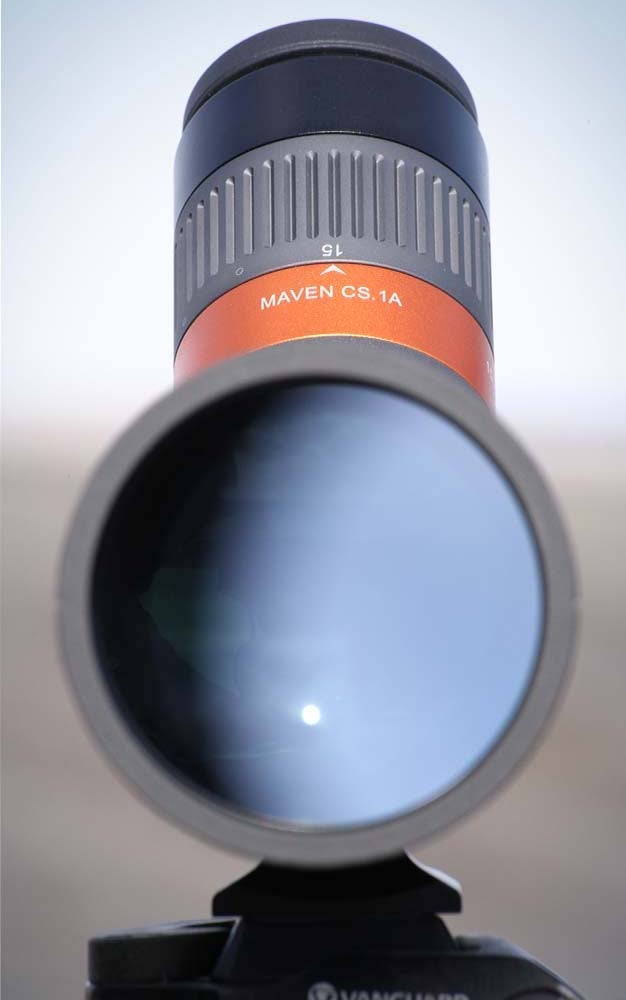
Product Description
This short (11.4-inches long) and compact 65mm spotter performs like an 80mm optic. The CS.1A updates Maven’s original straight-barrel compact spotter. Like its predecessor, this spotter has excellent glass, and both the magnification and focus rings move with silky precision. The angled eyepiece and mid-barrel rotation ring allow for an infinite number of glassing positions, and the orange collar adds nice contrast to the dark graphite armor.
The 15-45x magnification range is optimal for this size spotter. At 15x, the unit delivers a very bright and wide image, and at 45x, the image darkens but doesn’t degrade. I’d like to see a better tripod mount and a retractable sunshade, but the rest of the features seem nearly perfect, and the size and performance make it an essential piece of gear for just about any type of hunt.
Best Crossover: Tract Toric UHD 27-55×80
Key Features
- Magnification: 27-55x
- Objective lens: 80mm
- Weight: 67 ounces
- SCHOTT high transmission glass
- Removable eyepiece
- Distinctive graphite armor
- Argon filled
Why It Made the Cut
Direct-to-consumer brand delivers bright ED glass and quality Japanese build at a relatively accessible price.
Pros
- Ships with dust-resistant neoprene jacket
- Silky controls
- Interchangeable 22-power eyepiece with MRAD PRS reticle available
- Well-balanced tripod mounting shoe
Cons
- Removable eyepiece design can allow dust and grit to enter body
Product Description
The first spotter from this direct-to-consumer is a versatile powerhouse. The focus, magnification ring, and retractable sunshade all move with silky precision. And the 27-55-power zoom range covers most hunting scenarios, while the 80mm objective lens—made with extra-low dispersion glass—lets in plenty of light. Precision rifle shooters will appreciate the fixed 22-power lens that contains a milling PRS reticle, which allows users to make precise calls when spotting for a long-distance shooter.
Best Versatile: SIG Sauer OSCAR8 27-55×80
Key Features
- Magnification: 27-55x
- Objective lens: 80
- Weight: 67.2 ounces
- Removable variable-power eyepiece
- Tough, grippy flat dark earth armor
Why It Made the Cut
A great all-around spotter, the SIG OSCAR8 has enough optical horsepower for most hunting situations and exterior styling that fits right at home on a rifle range.
Pros
- Angled eyepiece and rotating tripod collar enables multiple viewing angles
- High-resolution, bright image
- Removable eyepiece can be traded out for other variable or fixed-power eyepieces
- Ships with custom-fit neoprene jacket
Cons
- Center-barrel control is hard to finely focus
Product Description
A handsome, versatile, and rugged spotting scope, the OSCAR8 has a sensibly restrained magnification range that zooms from 27 to 55x. At low magnifications, the SIG has a bright image and wide field of view. At 40 to 55x, the scope has enough power to enable users to count points on a distant buck without making the image maddeningly dark. I hunted with this scope during Montana’s elk season, and it took in stride all the temperature changes, bumps and drops, and dust the hunts dealt it. Should the spotter ever fail, it’s fully backed by SIG’s excellent five-year warranty.
Best Tactical: Bushnell Elite Tactical LMSS2 8-40×60
Key Features
- Magnification: 8-40x
- Objective lens: 60mm
- Weight: 40.7 ounces
- Eyepiece contains Horus H-32 milling reticle
- Multiple attachment points for Picatinny rails
- Durable FDE or black armor
Why It Made the Cut
The Bushnell Elite Tactical LMSS2 is the perfect companion for precision rifle shooting. The integrated reticle allows spotters to communicate to their shooting partner specific holds and call shots with precision and clarity.
Pros
- Reticle matches those in precision riflescopes
- Throw lever makes magnification changes fast
- Slender build easily fits in backpack sleeve
- Utilizes Bushnell’s best glass and coatings
Cons
- Excessively heavy for a 60mm walk-about spotter
Product Description
Purpose-built as an aid to precision rifle shooters, the integrated reticle in the LMSS2 allows spotters to effectively call shots for their teammates on rifle. The straight-style tactical spotter is built like a tank, with double-tough armor and attachment points for Picatinny rails, so you can add accessories like thermals or lights to the optic. Alternatively, the rails allow you to mount the LMSS2 on either rails or a traditional tripod. The ED glass works pretty well, but the real appeal here is the Horus reticle inside and tactical bling on the exterior.
Best Value: Meopta MeoStar S2 82HD
Key Features
- Magnification: 30-60x
- Objective lens: 82mm
- Weight: 50.4 ounces (without eyepiece)
- Straight-body design
- Interchangeable eyepieces
- Apochromatic objective lens
Why It Made the Cut
While there’s no shortage of angled-body spotting scopes, it’s rare to find a premium straight-body-design like the MeoStar S2, and its ability to trade out eyepieces makes it extremely versatile.
Pros
- Fast target acquisition
- Excellent glass
- Oversized center-barrel focus easy to turn with gloves
- Select either 20-70x or 30-60x eyepieces
Cons
- Eyepieces purchased separately from body
Product Description
A product-line extension following Meopta’s successful angled MeoStar S2, this 82mm spotter has the optical horsepower for just about any hunting situation, and the straight-barrel design makes it easy to slide into a backpack sleeve. The unit defaults to a 20-70x eyepiece, which you have to purchase separately from the body, but the wide-angle 30-60x eyepiece may have even more utility. That’s because any object you can see at 60x will only darken at 70x, so the additional magnification might not be worth the degradation in image. And the wide-angle eyepiece provides a constant 66-degree field of view throughout the entire magnification range.
The straight-barrel design will appeal to viewers who want to make quick target acquisition, instead of the hunting-and-pecking sometimes required with angled eyepieces. In all, the Meopta compares favorably to premium spotters from Swarovski, Leica, and Zeiss at a lower price.
Best Entry-level: Vanguard VEO HD 80A 20-60×80
Key Features
- Magnification: 20-60x
- Objective lens: 80mm
- Weight: 54.7 ounces
- Angled eyepiece
- Mid-barrel focus
- Retractable sunshade
Why It Made the Cut
In a category with multiple $1,500-and-higher submissions, the Vanguard VEO HD costs less than $400, but will deliver years of service.
Pros
- Accessible price point
- Angled eyepiece and tripod rotation enable wide range of viewing options
- One-piece design minimizes internal dust
Cons
- Slick finish is hard to grip
- Image degrades at higher magnifications
Product Description
Built on a composite-carbon chassis, the Vanguard VEO HD runs lighter than its peers, which makes this 80mm spotter a good choice for backcountry hunting. The angled eyepiece and rotating tripod mount increase its versatility, and the controls are relatively tight and precise, especially for the at around $400.
Demerits include the slippery, non-textured armor and the underwhelming glass, which makes images above about 45-power pretty dark and grainy with some distorted edge detail. Still, if you use this scope in daylight and don’t max out its magnification, it’s a worthy companion for most hunting situations or first-time buyers.
Best Micro: Hawke Nature-Trek 9-27×56
Key Features
- Magnification: 9-27x
- Objective lens: 56 mm
- Digi-scope compatible
- Angled eyepiece
- Mid-barrel focus
Why It Made the Cut
This wee spotter fills the gap between a binocular and a full-sized scope and is remarkably portable.
Pros
- Lighter than most binoculars
- Integrated eyepiece minimizes internal debris
- Fits in jacket pocket
Cons
- Image darkens around 20x
- Relatively fragile for many field uses
Product Description
Given that many full-sized spotters can weigh upwards of four pounds and require a tripod in order to stabilize, this little hand-sized spotter packs easily and can reach out to objects beyond binocular range. The 9-27x magnification range is useful, and while the image starts to degrade at magnifications above about 20x, it’s a great daytime optic for birders, go-light hunters, and travelers.
The controls, both the eyepiece magnification control and the mid-barrel focus, turn with precision, and the Nature-Trek has a reasonable price. Other good touches include a neoprene soft case to protect the unit and an infinitely adjustable eyecup. Demerits include underwhelming glass and a tripod mount that can’t handle too much torque. Still, the best spotter is the one you have with you, and it’s easy to always have the Hawke Nature-Trek in your pocket.
Athlon Argos HD 20-65×85
Key Features
- Magnification 20-60x
- Objective lens: 85mm
- 45-degree angled eyepiece
- Center-barrel focus
- HD glass in objective lens
Why It Made the Cut
This full-sized spotting scope handles most field and firing-range tasks well under $500.
Pros
- Entry-level price point
- 85mm objective passes plenty of light
- Tight and precise controls
Cons
- Underwhelming image at high powers
Product Description
An entry-level spotting scope from a brand that has become synonymous with quality optics at accessible prices, the Argos HD brings a big, light-hungry 85mm build to customers for well under $500. The 45-degree eyepiece and center-barrel tripod ring enables an infinite number of deployment options, and the 20-60x magnification range suits a wide variety of field tasks.
I noted some optical distortion, especially when I used the Argos in bright light, and the low-light resolution disappointed at high magnifications. Durability is decent, though Athlon’s transferable lifetime warranty should alleviate any concerns about long-term integrity of the optic. This is a lot of glass for walk-about hunting, but works perfect as a pickup scope or a tripod-mounted optic for a picture window or patio.
FAQs
Q: What is the best magnification for a spotting scope?
The best magnification for a spotting scope depends on how you plan to use it. But generally, the sweet spot between magnification and image quality is somewhere in the middle of the power range. Say you have a 20- to 60-power eyepiece on an 80mm spotter. The best brightness and image quality will be at 20x, but the image will be smallest at that magnification. At 60-power, the image will be largest, but because of the laws of optics, it also appears darkest and grainiest. This same middle-is-best trade-off applies to every magnification range, from 9-27-power spotters to 20-60-power eyepieces.
Q: Is angled or straight better for a spotting scope?
Whether you choose an angled or a straight-body spotting scope is largely a matter of personal preference. Models that have both designs typically have identical glass, magnification ranges, and components, so they’ll likely deliver an identical image. Some users like angled eyepieces because of their versatility. If you’re sitting beside a buddy, you can frame a distant deer, and by simply rotating the barrel, turn the eyepiece to your buddy so they can view the deer. With a straight-body spotting scope, you’d have to trade places with your buddy in order for them to see the deer. However, it can be hard to get your scope on target with an angled eyepiece because the 45-degree angle means the eyepiece isn’t pointing at your target, like a straight-body spotter, so target acquisition occurs much faster.
Q: How are spotting scopes measured?
Spotting scopes are measured with two numbers. The first is the magnification, which generally refers to a range between the lowest and highest magnification. The second number is the size of the objective lens in millimeters. So a 20-60×80 spotter has a 20- to 60-power eyepiece and an 80mm objective lens. A 15-45×65 unit has 15- to 45-power magnification behind a 65mm objective lens.
Q: What distance are spotting scopes good for?
Spotting scopes are good from fairly close to nearly infinity. While the best binoculars for hunting have close focus of about 6 to 8 feet, spotting scopes can only focus to about 12 feet. Spotting scopes work best from mid to far distances. At middle distances, like 50 to 400 yards, you can usually zoom in to see precise details of your target. At longer distances, from 400 yards to infinity, you lose resolution in the magnified image, but you’ll still be able to see details that you could never see with your naked eye or even a binocular.
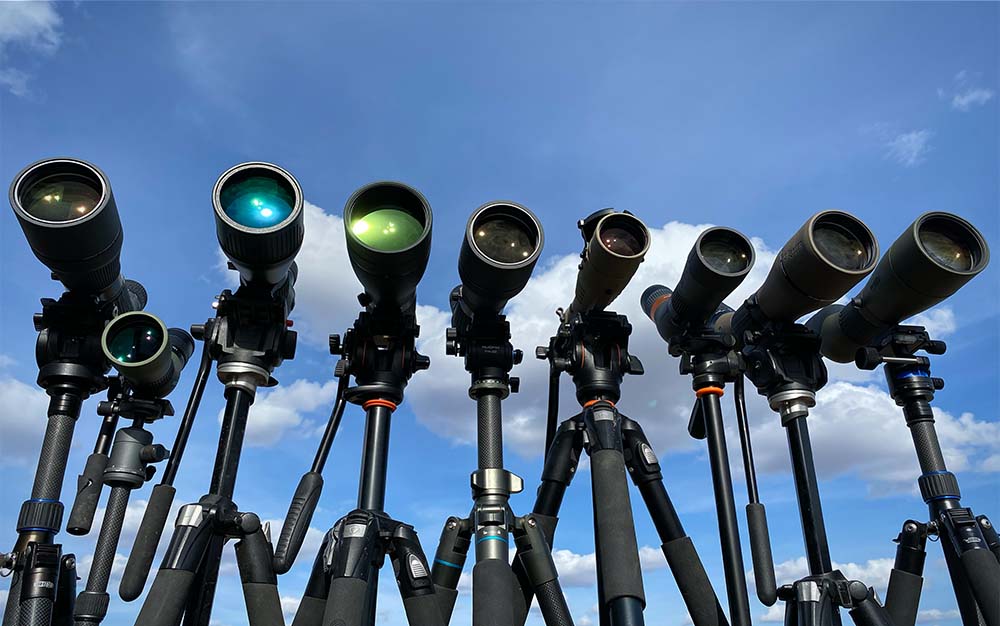
Methodology
Because it’s nearly impossible to evaluate the merits of a spotting scope simply by handling it and turning its controls, I strapped every entry to tripods. Then, I put each through a field course, and viewed close, mid-range, and far targets. I then assessed how the image looked at each distance and in various light conditions. And I compared attributes such as eye relief, brightness, and field-of-view against each entry and also measured resolution (how much detail each could deliver) by counting lines on a black-and-white target at 200 yards.
I also made subjective assessments of the controls—how easy or tight the power ring or focus turned, how comfortable were the eyecups, and how durable each unit felt. For comfort, I rated each submission and determined which ones made me squint and which ones provided several hours of comfortable glassing. Lastly, I assessed the extras included with each product and their individual warranties.
Final Thoughts
Spotters represent a significant investment. And unless you have great reasons to own a spotting scope, picking the right model for your budget and purpose will require a lot of careful thought. Like other optics categories, spotters fall all over the map in terms of quality, price, and performance, but luckily, this review should help you narrow down the best spotting scopes for your specific needs and budget.
The post The Best Spotting Scopes of 2022 appeared first on Outdoor Life.
||-------------------------------------
By: Andrew McKean
Title: The Best Spotting Scopes of 2022
Sourced From: www.outdoorlife.com/gear/best-spotting-scopes/
Published Date: Thu, 28 Apr 2022 19:30:58 +0000
.png)
